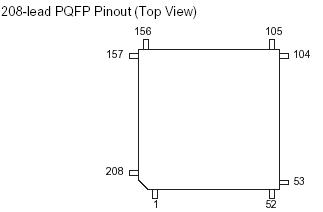Features: • Incorporates the ARM920T™ ARM® Thumb® Processor
200 MIPS at 180 MHz, Memory Management Unit
16-KByte Data Cache, 16-KByte Instruction Cache, Write Buffer
In-circuit Emulator including Debug Communication Channel
Mid-level Implementation Embedded Trace Macrocell (256-ball BGA Package Only)
• Low Power: 30.4 mA on VDDCORE, 3.1 mA in Standby Mode
• Additional Embedded Memories
16K Bytes of SRAM and 128K Bytes of ROM
• External Bus Interface (EBI)
Supports SDRAM, Static Memory, Burst Flash, Glueless Connection to CompactFlash®, SmartMedia™ and NAND Flash
• System Peripherals for Enhanced Performance:
Enhanced Clock Generator and Power Management Controller
Two On-chip Oscillators with Two PLLs
Very Slow Clock Operating Mode and Software Power Optimization Capabilities
Four Programmable External Clock Signals
System Timer Including Periodic Interrupt, Watchdog and Second Counter
Real-time Clock with Alarm Interrupt
Debug Unit, Two-wire UART and Support for Debug Communication Channel
Advanced Interrupt Controller with 8-level Priority, Individually Maskable Vectored Interrupt Sources, Spurious Interrupt Protected
Seven External Interrupt Sources and One Fast Interrupt Source
Four 32-bit PIO Controllers with Up to 122 Programmable I/O Lines, Input Change Interrupt and Open-drain Capability on Each Line
20-channel Peripheral Data Controller (DMA)
• Ethernet MAC 10/100 Base-T
Media Independent Interface (MII) or Reduced Media Independent Interface (RMII)
Integrated 28-byte FIFOs and Dedicated DMA Channels for Receive and Transmit
• USB 2.0 Full Speed (12 Mbits per second) Host Double Port
Dual On-chip Transceivers (Single Port Only on 208-lead PQFP Package)
Integrated FIFOs and Dedicated DMA Channels
• USB 2.0 Full Speed (12 Mbits per second) Device Port
On-chip Transceiver, 2-Kbyte Configurable Integrated FIFOs
• Multimedia Card Interface (MCI)
Automatic Protocol Control and Fast Automatic Data Transfers
MMC and SD Memory Card-compliant, Supports Up to Two SD Memory Cards
• Three Synchronous Serial Controllers (SSC)
Independent Clock and Frame Sync Signals for Each Receiver and Transmitter
I2S Analog Interface Support, Time Division Multiplex Support
High-speed Continuous Data Stream Capabilities with 32-bit Data Transfer
• Four Universal Synchronous/Asynchronous Receiver/Transmitters (USART)
Support for ISO7816 T0/T1 Smart Card
Hardware and Software Handshaking
RS485 Support, IrDA Up To 115 Kbps
Full Modem Control Lines on USART1
• Master/Slave Serial Peripheral Interface (SPI)
8- to 16-bit Programmable Data Length, 4 External Peripheral Chip Selects
• Two 3-channel, 16-bit Timer/Counters (TC)
Three External Clock Inputs, Two Multi-purpose I/O Pins per Channel
Double PWM Generation, Capture/Waveform Mode, Up/Down Capability
• Two-wire Interface (TWI)
Master Mode Support, All 2-wire Atmel EEPROMs Supported
• IEEE 1149.1 JTAG Boundary Scan on All Digital Pins
• Power Supplies
1.65V to 1.95V for VDDCORE, VDDOSC and VDDPLL
1.65V to 3.6V for VDDIOP (Peripheral I/Os) and for VDDIOM (Memory I/Os)
• Available in a 208-lead PQFP or 256-ball BGA Package
Pinout
 Description
DescriptionThe AT91RM9200 is a complete system-on-chip built around the ARM920T ARM Thumb processor. It incorporates a rich set of system and application peripherals and standard interfaces in order to provide a single-chip solution for a wide range of compute-intensive applications that require maximum functionality at minimum power consumption at lowest cost.
The AT91RM9200 incorporates a high-speed on-chip SRAM workspace, and a low-latency External Bus Interface (EBI) for seamless connection to whatever configuration of off-chip memories and memory-mapped peripherals is required by the application. The EBI incorporates controllers for synchronous DRAM (SDRAM), Burst Flash and Static memories and features specific circuitry facilitating the interface for SmartMedia, CompactFlash and NAND Flash.
The AT91RM9200 Advanced Interrupt Controller (AIC) enhances the interrupt handling performance of the ARM920T processor by providing multiple vectored, prioritized interrupt sources and reducing the time taken to transfer to an interrupt handler.
The Peripheral Data Controller (PDC) provides DMA channels for all the serial peripherals, enabling them to transfer data to or from on- and off-chip memories without processor intervention. This reduces the processor overhead when dealing with transfers of continuous data streams.The AT91RM9200 benefits from a new generation of PDC which includes dual pointers that simplify significantly buffer chaining.
The AT91RM9200 set of Parallel I/O (PIO) controllers multiplex the peripheral input/output lines with generalpurpose data I/Os for maximum flexibility in device configuration. An input change interrupt, open drain capability and programmable pull-up resistor is included on each line.
The AT91RM9200 Power Management Controller (PMC) keeps system power consumption to a minimum by selectively enabling-/disabling the processor and various peripherals under software control. It uses an enhanced clock generator to provide a selection of clock signals including a slow clock (32 kHz) to optimize power consumption and performance at all times.
The AT91RM9200 integrates a wide range of standard interfaces including USB 2.0 Full Speed Host and Device and Ethernet 10/100 Base-T Media Access Controller (MAC), which provides connection to a extensive range of external peripheral devices and a widely used networking layer. In addition, it provides an extensive set of peripherals that operate in accordance with several industry standards, such as those used in audio, telecom, Flash Card, infrared and Smart Card applications.
To complete the offer, the AT91RM9200 benefits from the integration of a wide range of debug features including JTAG-ICE, a dedicated UART debug channel (DBGU) and an embedded real time trace. This enables the develop-ment and debug of all applications, especially those with real-time constraints.

 AT91RM9200 Data Sheet
AT91RM9200 Data Sheet








